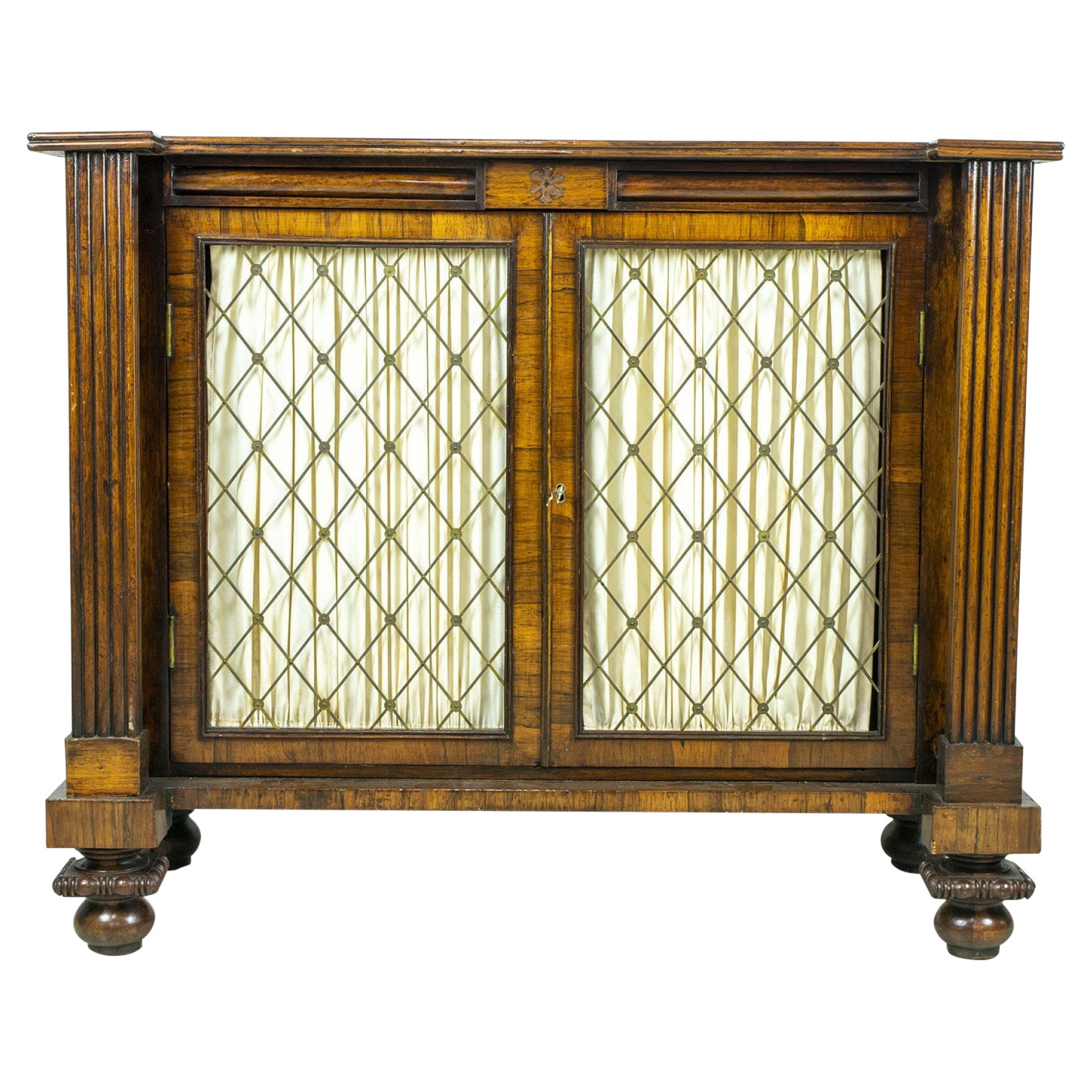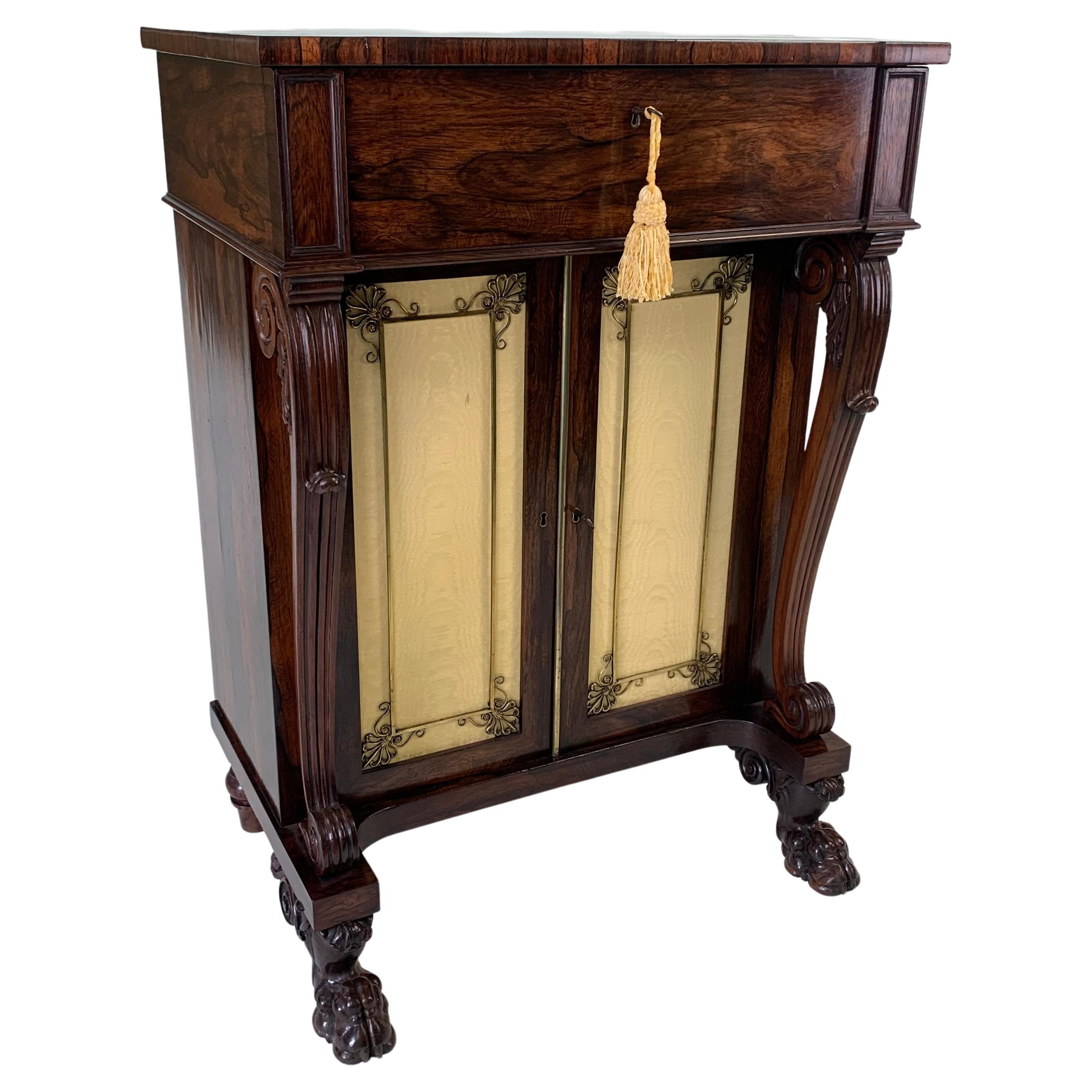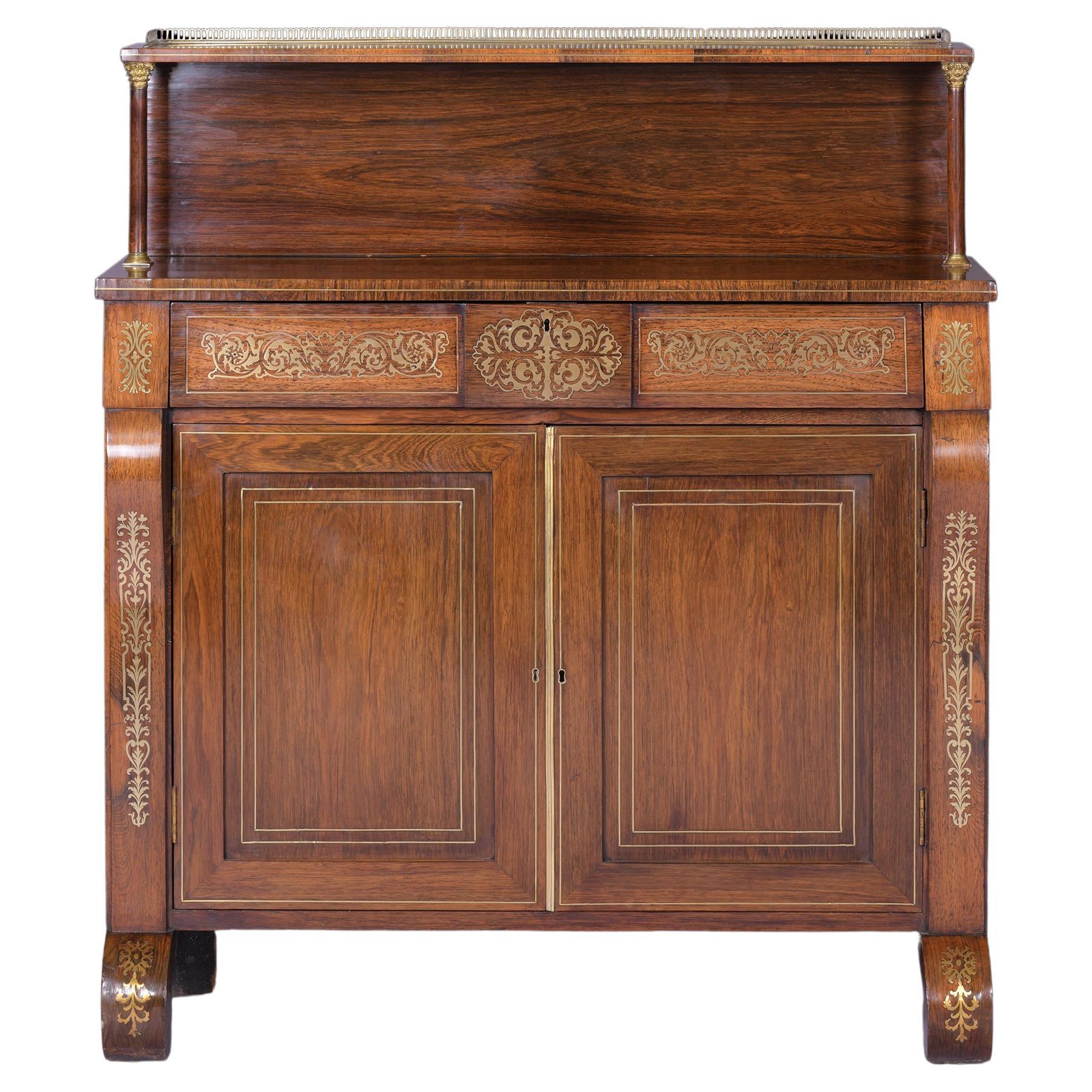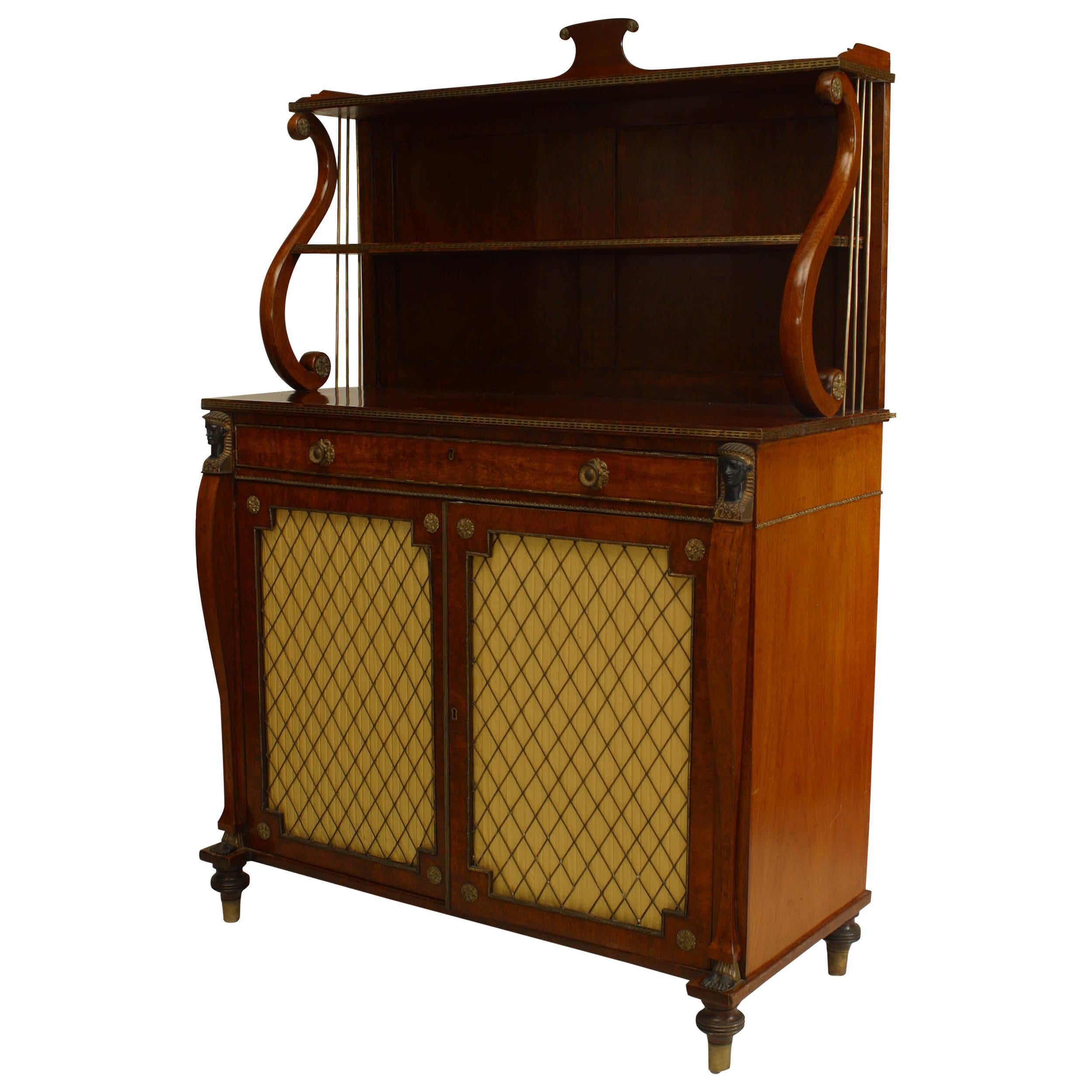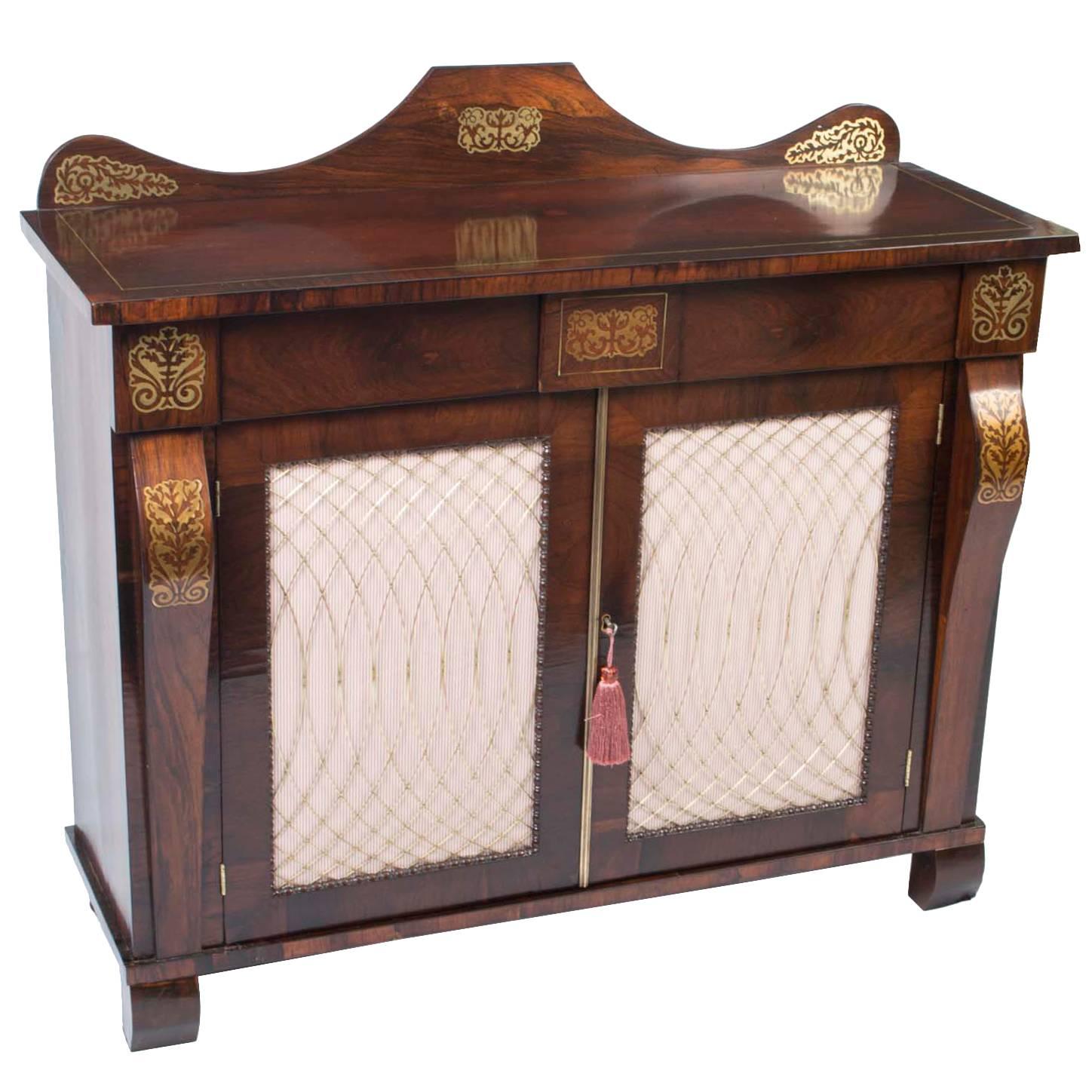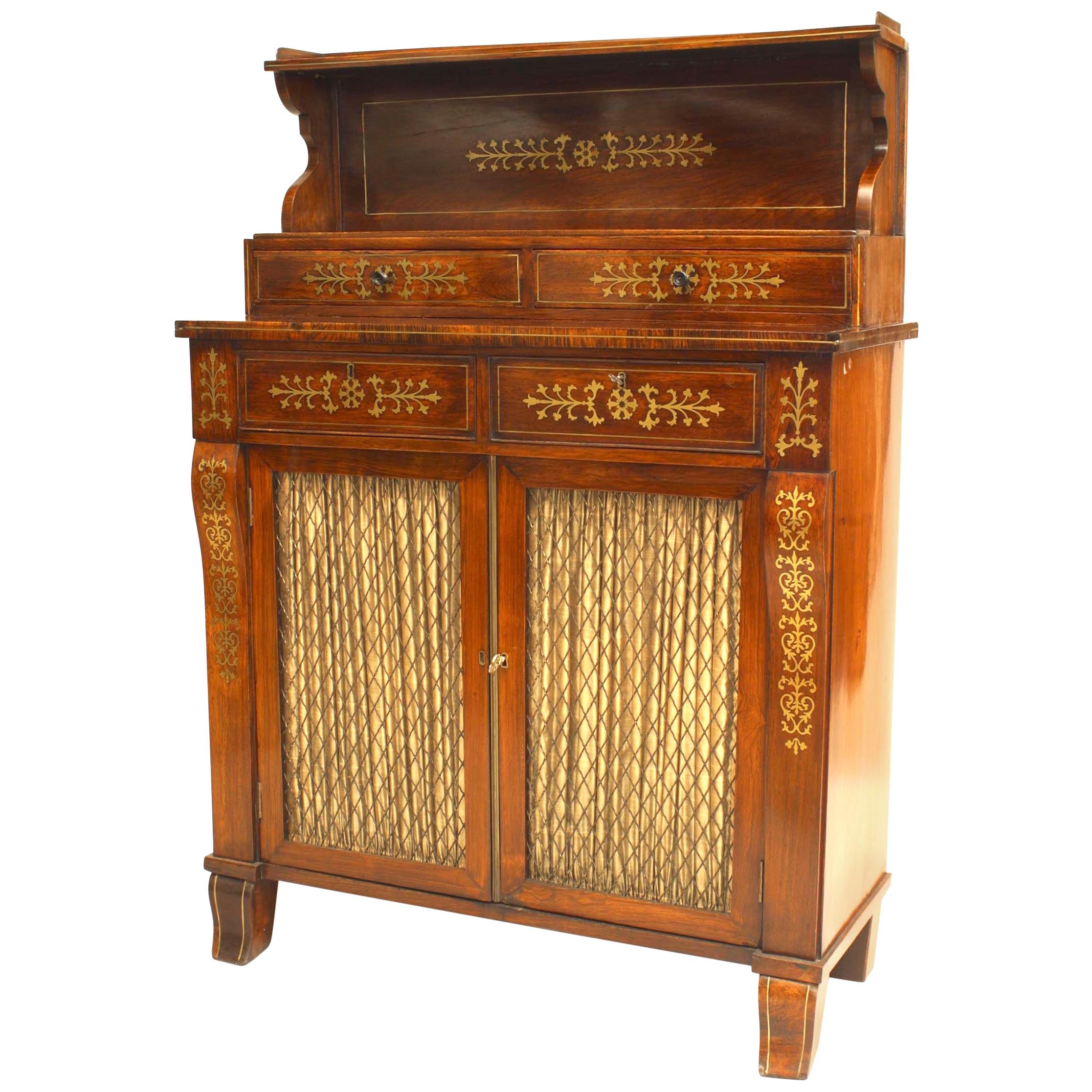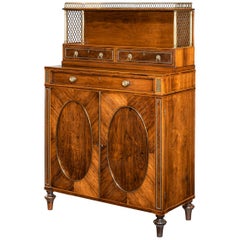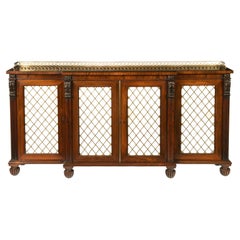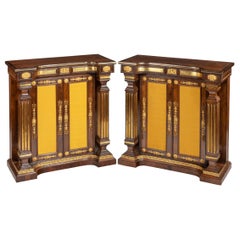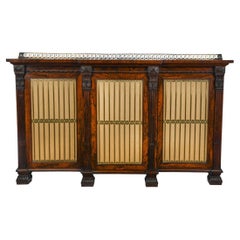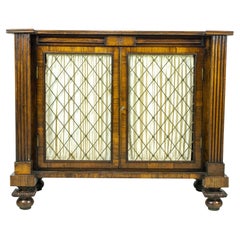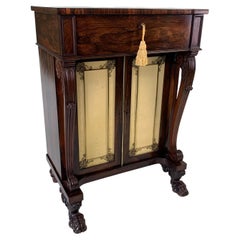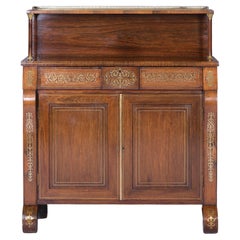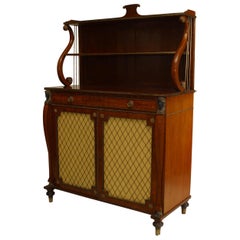Items Similar to Regency Brass-Inlaid Rosewood Secretaire Cabinet
Want more images or videos?
Request additional images or videos from the seller
1 of 10
Regency Brass-Inlaid Rosewood Secretaire Cabinet
$25,695.39
£18,750
€21,874.92
CA$35,196.26
A$39,145.92
CHF 20,440.78
MX$476,364.22
NOK 261,060
SEK 244,828.22
DKK 163,260.91
Shipping
Retrieving quote...The 1stDibs Promise:
Authenticity Guarantee,
Money-Back Guarantee,
24-Hour Cancellation
About the Item
A Regency brass-inlaid rosewood secretaire cabinet, the rectangular top with a pierced galleried shelf with trellis work on the sides, above a secretaire drawer, banded with brass palm leaves on an ebony ground, enclosing nine satinwood shelves flanking four pigeon holes, with a red leather-inset fall front writing surface, the lower section comprising silk-lined trellis panelled doors, all on ormolu lions’ paw feet, decorated overall with classical palmettes and anthemion, the later locks stamped ‘Turners W. Hampton Patent’. English, circa 1810.
Provenance: The Marquess of Bristol and by descent to the late Frederick, 7th Marquess of Bristol, Ickworth, Suffolk, from whom bought privately by the present owner and kept at Ellerslie House.
Footnote: A pattern for this secretaire was entitled a ‘Lady’s Secretary’ and featured in Thomas Sheraton’s, ‘Cabinet Maker and Upholsterer’s Drawing Book’, 1791-3, Part III, pl XLIII. However various elements in the style and ornament of this piece relate to the work of John McLean & Son, Marylebone Street subscribers to Thomas Sheraton’s 1803 ‘Cabinet Dictionary’. For a related secretaire by McLean in the Victoria and Albert Museum see C Gilbert, ‘Pictorial Dictionary of Marked London Furniture 1700-1840.’ Leeds, 1996, fig. 596.
- Dimensions:Height: 49 in (124.46 cm)Width: 34.75 in (88.27 cm)Depth: 18 in (45.72 cm)
- Style:Regency (Of the Period)
- Materials and Techniques:
- Place of Origin:
- Period:
- Date of Manufacture:1810
- Condition:Wear consistent with age and use.
- Seller Location:Lymington, GB
- Reference Number:1stDibs: LU973023924872
About the Seller
5.0
Recognized Seller
These prestigious sellers are industry leaders and represent the highest echelon for item quality and design.
Established in 1982
1stDibs seller since 2013
132 sales on 1stDibs
Typical response time: 2 hours
Associations
LAPADA - The Association of Arts & Antiques Dealers
- ShippingRetrieving quote...Shipping from: Lymington, United Kingdom
- Return Policy
Authenticity Guarantee
In the unlikely event there’s an issue with an item’s authenticity, contact us within 1 year for a full refund. DetailsMoney-Back Guarantee
If your item is not as described, is damaged in transit, or does not arrive, contact us within 7 days for a full refund. Details24-Hour Cancellation
You have a 24-hour grace period in which to reconsider your purchase, with no questions asked.Vetted Professional Sellers
Our world-class sellers must adhere to strict standards for service and quality, maintaining the integrity of our listings.Price-Match Guarantee
If you find that a seller listed the same item for a lower price elsewhere, we’ll match it.Trusted Global Delivery
Our best-in-class carrier network provides specialized shipping options worldwide, including custom delivery.More From This Seller
View AllRegency Rosewood Two-Door Side Cabinet, Attributed to John Mclean
By John Mclean
Located in Lymington, Hampshire
A fine high Regency rosewood two-door side cabinet, attributed to John Mclean, of upright rectangular form, the upper section comprising two small drawers ...
Category
Antique 1810s English Regency Cabinets
Materials
Rosewood
Late Regency Rosewood Breakfront Four Door Side Cabinet, Attributed to Gillows
Located in Lymington, Hampshire
A late Regency rosewood breakfront four door side cabinet, attributed to Gillows, the shaped top with a brass gallery above four doors fitted with trellis-and-rosette grilles relined...
Category
Antique 1810s English Regency Bookcases
Materials
Silk, Rosewood
Pair of Regency Brass-Inlaid Rosewood Side Cabinets
Located in Lymington, Hampshire
A pair of Regency brass-inlaid rosewood side cabinets, each of rectangular form with a concave frieze concealing a button to open a pair of glazed with doors re-lined in yellow silk ...
Category
Antique 19th Century British Regency Cabinets
Materials
Brass
$99,698 / set
George IV Period Rosewood Chiffonier or Side Cabinet with Carved Detailing
Located in Lymington, Hampshire
A Fine George IV Period Rosewood Chiffonier or Side Cabinet with Carved Detailing and Ormolu Gallery, of breakfront form, this fine piece is veneered throughout in the highest quality rosewood. It combines fine carved details such as the moulding on the frieze, the floral paterae, reeded ogee feet and the stop fluted columns with the use of gilt brass or ormolu. The doors retain their original gilt brass door panels...
Category
Antique Early 19th Century English George IV Cabinets
Materials
Rosewood
Rosewood Regency Kneehole Bureau Cabinet Attributed to Seddon and Morel
By Morel & Seddon
Located in Lymington, Hampshire
An impressive and monumental rosewood Regency kneehole bureau cabinet with ormolu mounts of exceptional quality, attributed to Seddon and Morel, the central roll-top opening to revea...
Category
Antique 19th Century English Regency Cabinets
Materials
Ormolu
Victorian Satinwood Breakfront Side Cabinet Attributed to Dyer and Watts
Located in Lymington, Hampshire
A Victorian satinwood breakfront side cabinet with Wedgwood plaques attributed to Dyer and Watts, the shaped top above a central door flanked by two gla...
Category
Antique 19th Century English Victorian Cabinets
Materials
Ormolu
You May Also Like
English Regency Brass Inlaid Rosewood Side Cabinet
Located in Queens, NY
English Regency (1st quarter 19th century) rosewood side cabinet with a drawer over 2 brass grill doors and side panels having a silk cloth lining with reeded pilaster sides and rais...
Category
Antique 19th Century British Regency Cabinets
Materials
Metal, Brass
Regency Rosewood Secretaire Side Cabinet/Chiffoneer
Located in Folkestone, GB
A superior quality and unusual Regency rosewood Side Cabinet, the top drawer with fold-down, leather-lined front, fully fitted with drawers and pigeon holes. below are a pair of silk...
Category
Antique Early 19th Century English Regency Cabinets
Materials
Rosewood
Early 19th Century English Regency Brass Inlaid Secretaire Chiffonier
Located in Dublin, IE
The superstructure with a rectangular three quarter gallery shelf on a pair of turned Corinthian pillars. Profusely inlaid with engraved brass scrolling foliate and floral marquetry ...
Category
Antique Early 19th Century English Regency Cabinets
Materials
Brass
English Regency Rosewood Secretaire
Located in Queens, NY
English Regency rosewood secretaire cabinet with two upper shelves supported by a lyre form over a secretaire drawer fitted with a leather wri...
Category
Antique Mid-19th Century English Regency Secretaires
Materials
Rosewood
19th Century Regency Brass Inlaid Cabinet Chiffonier
Located in London, GB
This is an elegant antique Regency period brass inlaid goncalo alves chiffonier, circa 1820 in date.
This magnificent cabinet has an arched shaped back and features a pair of grilled doors with powder pink silk linings that open to reveal a cupboard with a central shelf.
There are two useful drawers in the frieze, the cabinet stands on elegant turned feet and the inlaid brass decoration compliments this piece beautifully.
The chiffonier is equipped with the original working lock and key.
Add a touch of class to a special place in your home with this beautiful antique sideboard...
Category
Antique 1820s English Regency Cabinets
Materials
Brass
Regency Mahogany and Brass Inlaid Sideboard
Located in Queens, NY
English Regency mahogany and brass inlaid 2 drawer small sideboard cabinet with 2 grill doors and upper section.
Category
Antique 19th Century British Regency Sideboards
Materials
Brass
More Ways To Browse
Antique Inlaid Cabinet
Antique Cabinet Locks
Leather Door Cabinet
Antique Brass Stampings
Inlaid Rosewood
Lion Cabinet
Rosewood Panels
Drawing Storage Cabinet
Brass Inlaid Regency Furniture
English Regency Cabinet
Palm Cabinet
Antique Red Kitchen Cabinets
Antique Drawing Cabinet
W Hampton
Brass Lady
Regency Lion Paw
Used Kitchen Cabinets London
Pigeon Hole Storage
